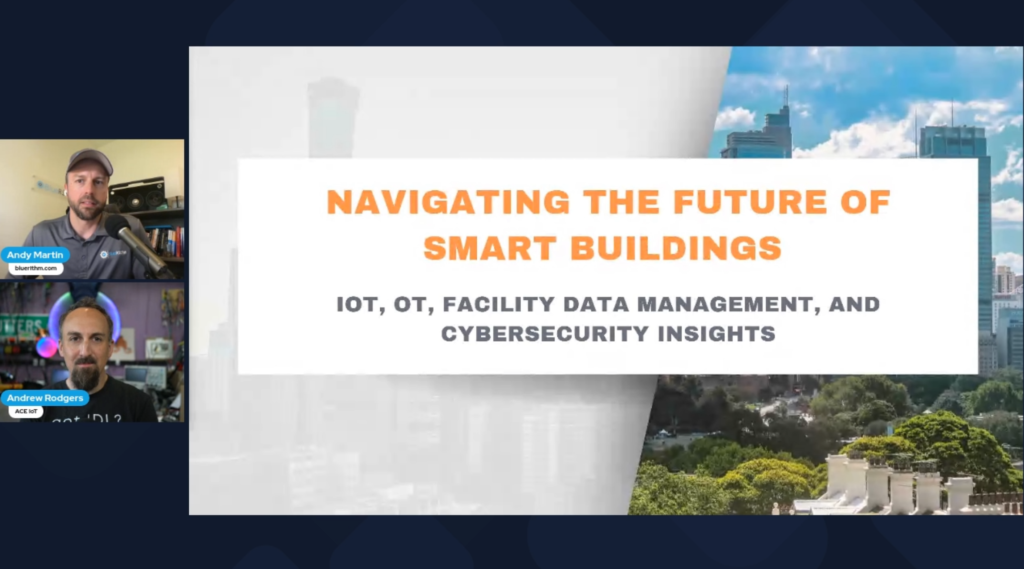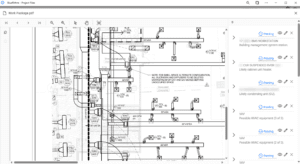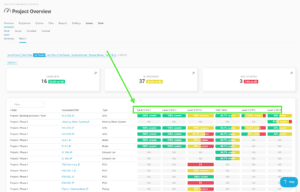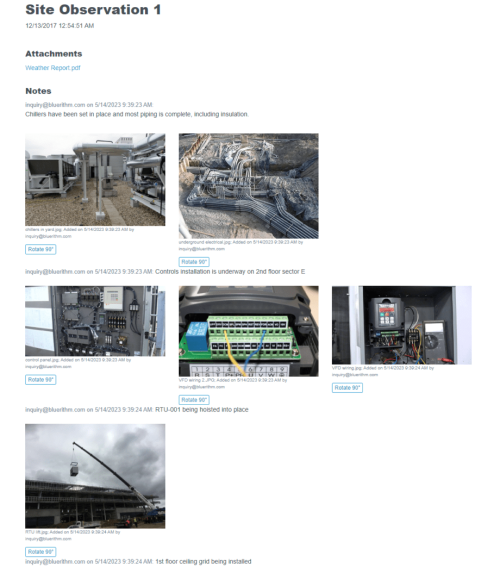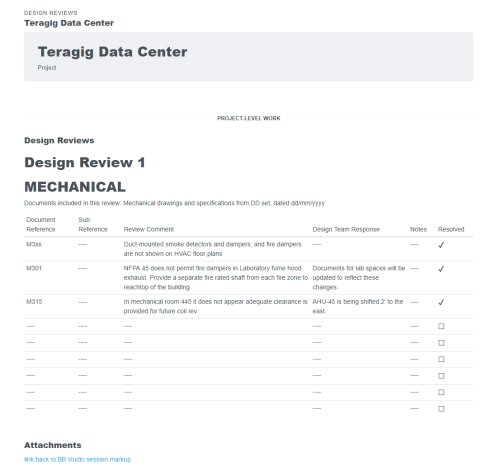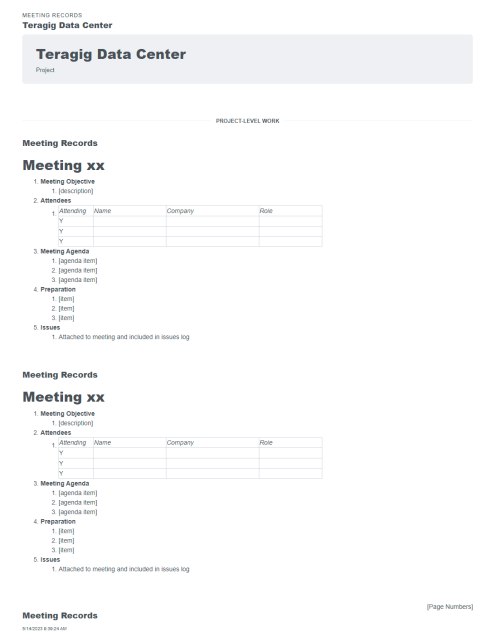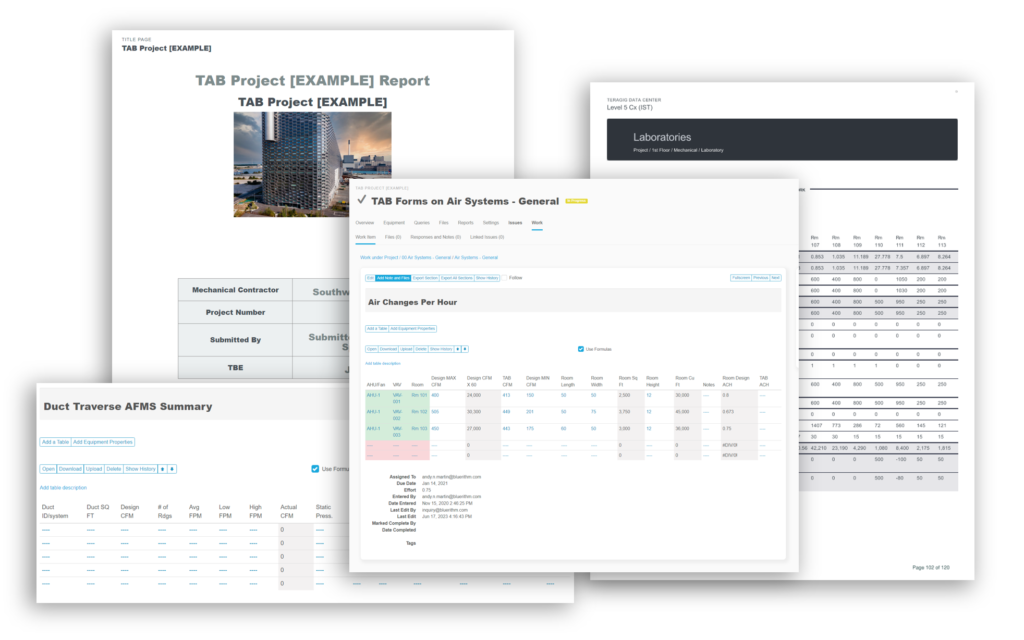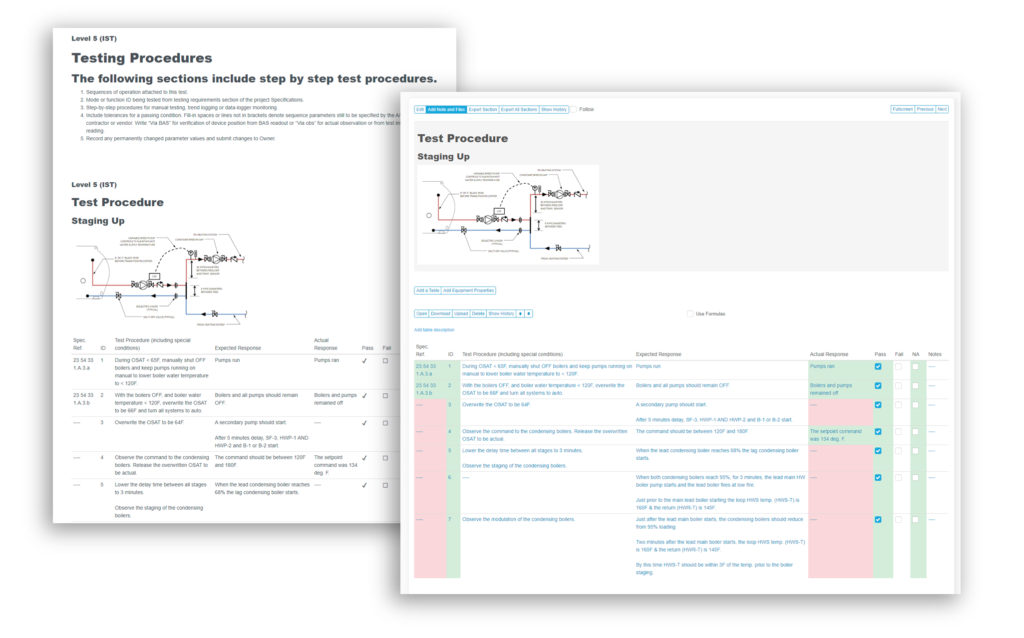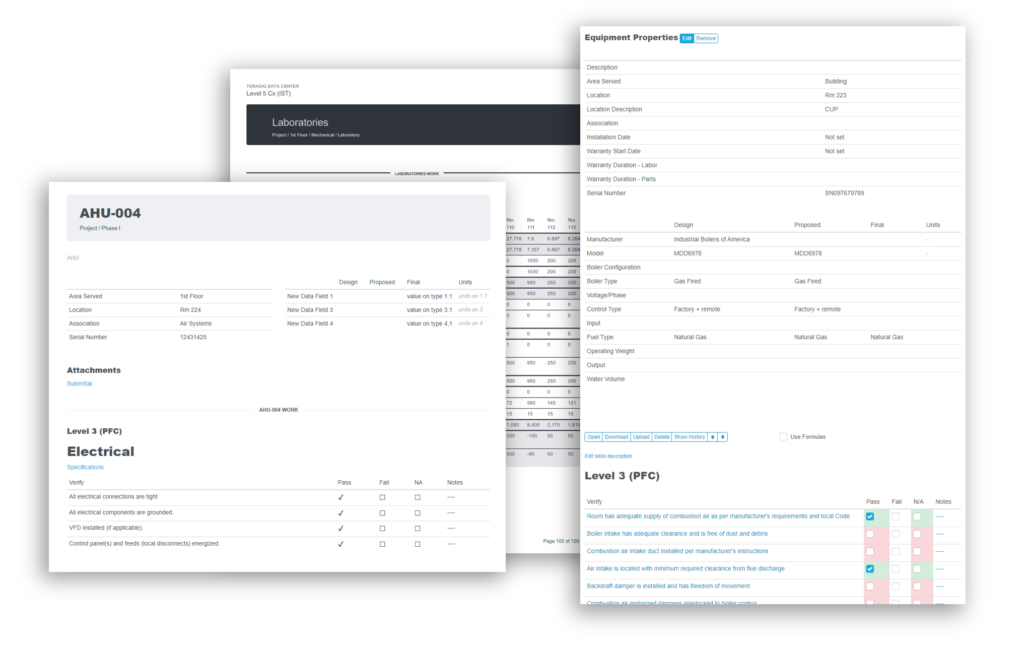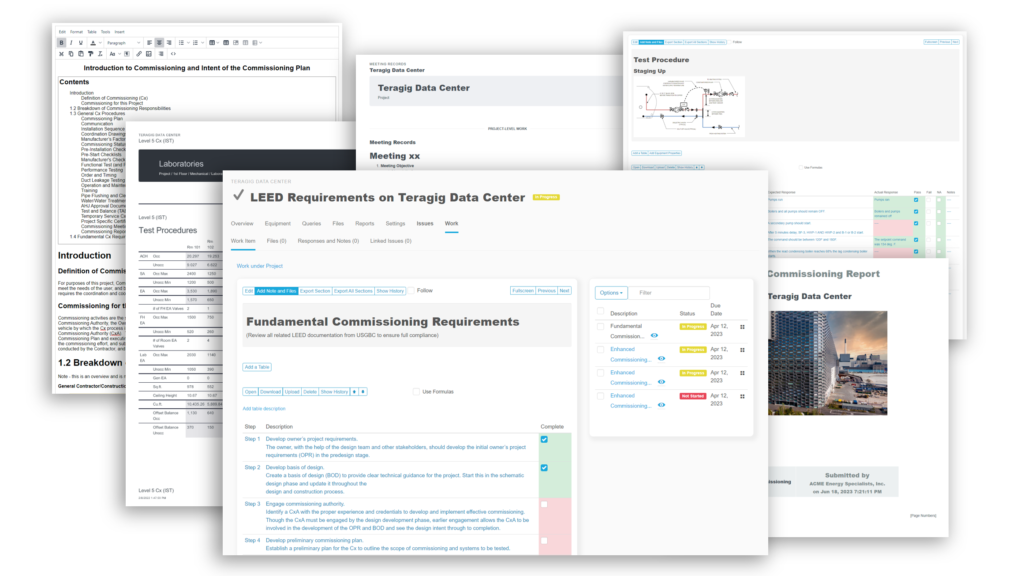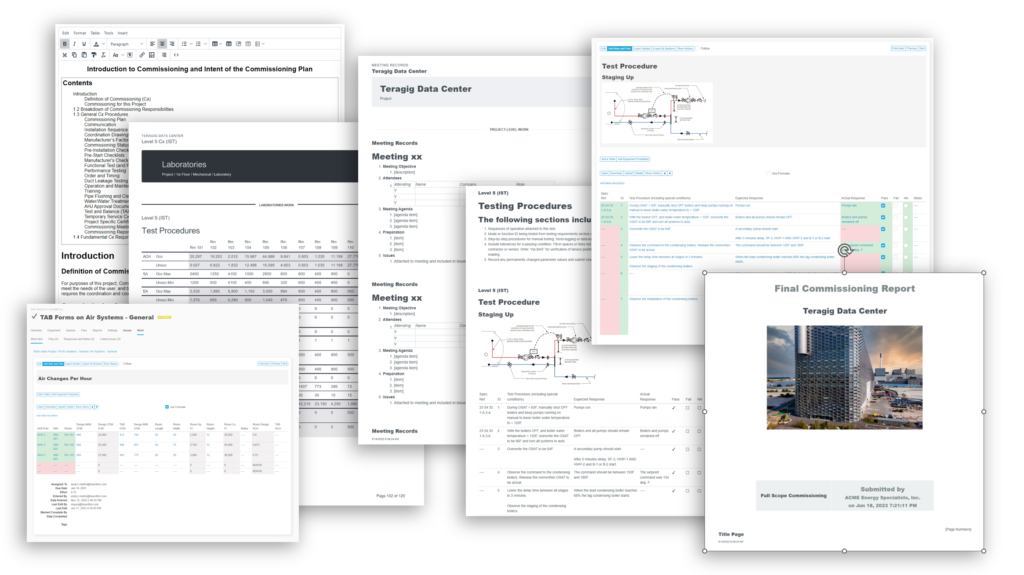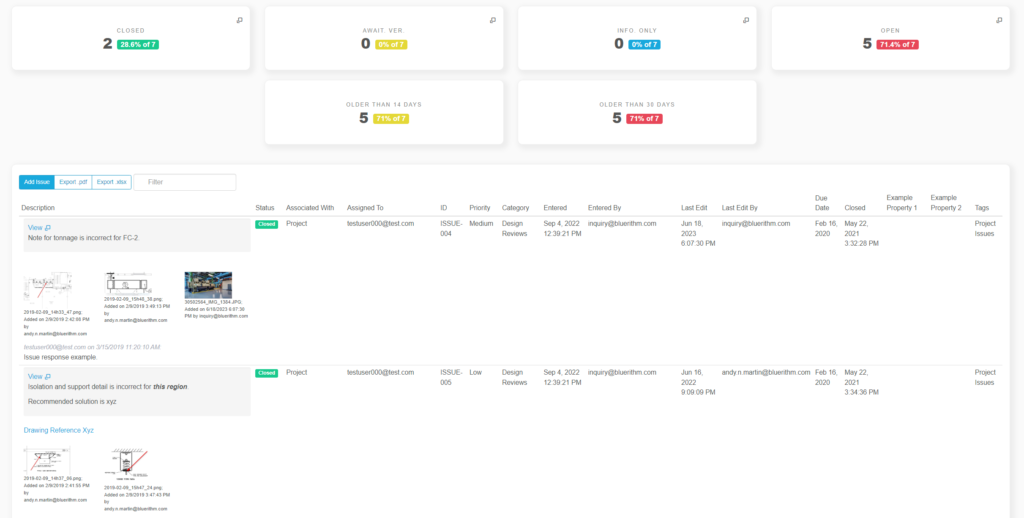Episode notes
Notes from Andrew Rodgers:
Anyone listening should check out https://www.nexuslabs.online/ this community has really brought together everyone exasperated with the status quo in the commercial buildings industry. I’ve had amazing conversations with the folks I’ve met through Nexus.
If you’re more on the technical end, or are looking for resources to help you get started on the technology side, the Discord server ACE IoT hosts is a great resource, with a super helpful community of practitioners from both technology and built-environment backgrounds, you can join here: https://discord.gg/z5c27uBV
Transcript
Andrew Rodgers: [00:00:00] Good afternoon, Andrew. How are you today?
I’m great. How are you, Andrew?
Andy Martin: Doing well, sir. Thank you.
Andrew Rodgers: You’ve adopted Andy for this call. Is that, is that how this works?
Andy Martin: Just to keep things simple for everybody, we’ve, we’ve gone with different, different names today. So we decided to get together and talk a little bit about smart buildings, building technology, standards, IoT, OT, and.
Try to sort some of this stuff out for people and talk about what you’re, what you’re seeing and what you guys are doing in the, in the market right now.
Andrew Rodgers: We’re excited to talk about it with you. Really, um, been fun watching Bluerithm uh, lead the space in adopting technology in the commissioning process. Uh, a lot of our customers tend to be commissioning engineering firms.
Folks who are offering, uh, continuous commissioning [00:01:00] or monitoring based commissioning services. Um, and so there’s a lot of overlap between, I think, our customer bases. And, uh, you know, it’s, it’s just really been fun over the years. I found out, you know, learned about you back 10 years ago or so when I was working with another commissioning firm and we were comparing and considering different commissioning platforms.
And it’s just really cool to see how y’all have grown and the technologies you’ve adopted. I think you’re probably, you know, leading the way on some of the intersection with other, um, other technologies and not just reporting and, and kind of the traditional commissioning workflow stuff.
Andy Martin: Yeah. Oh, I appreciate you saying that.
Um, it’s, it’s definitely the way we, we think about things. It’s, it’s not so much a matter of, you know, digitizing spreadsheets and whatnot anymore. It’s about connecting tools together and eliminating all of the, the, the work that gets repeated over and over and over again, as we’re moving data from design tools and design teams to construction teams, to [00:02:00] commissioning teams, to owners.
Uh, there’s just a lot of that going on that, that can definitely be reduced. And. And some of that comes down to standards and, uh, different ways that we can, uh, move data around. And that’s some of what we’re going to, we’re going to talk about today. And, uh, excited to, to jump into that with you. \
can you talk a little bit about just from a general standpoint? What is, what does IoT mean? What does OT mean? What’s the difference? Um, and how does this stuff fit into the context of commercial buildings and smart buildings, especially?
Andrew Rodgers: Yeah, so, um, in full transparency, because I have a lot of opinions about this, but I went and kind of checked some references before this conversation because I knew this question was going to come up.
You know, traditionally, OT has meant physical or cyber physical systems in sort of, you know, Uh, [00:03:00] Real world environments, plants, buildings, anything where you have, you know, energy systems that are being controlled that are pretty critical, right? Like you can’t, um, you know, you’re, you can’t have a, a, a high pressure steam line with the same reliability as like, uh, You know, your Alexa smart, um, you know, doorbell or whatever.
So, uh, I think most people are with IOT at this point, uh, in the, their home space, you know, they’re, they have smart doorbells, they have smart light switches. They have. Uh, you know, smart fridges and toasters and everything else that sometimes it feels like is getting shoved down our throats on that side of the world.
Um, but they’re also really familiar with the pains of that. Um, you know, there’s been so many high profile, uh, companies that have developed really interesting, potentially interesting, um, you know, applications of IoT. And [00:04:00] then, you know, For whatever reason, don’t have a good product market fit, don’t quite reach the scale that their funders expected them to, etc.
And then they disappear and all the infrastructure that ran that, that IOT platform disappears and people are left with nothing. You know, pretty expensive bricks. And I think that’s really where the differentiation between IOT and OT comes down to at this point. Because the technologies themselves have converged so much, it’s really the same kinds of software and hardware.
It’s really about the business models that are involved, how you’re paying for it, how explicit you are about paying for the ongoing maintenance so you know that it’s going to be a reliable system over time. There’s another term that doesn’t get used in buildings very much, but on the industrial side there’s like this idea of industrial IO ot, IIOT, and I think that is sort of the term that I use it sometimes, but I think it sort of condenses that [00:05:00] idea that like, yeah, it’s all software and hardware mashed together in a, you know, a IP connected world.
But in this IIOT world, we’re much more concerned about. Uh, you know, reliability, robustness of the hardware, you know, what’s the business model I’m buying it through? Is it something that’s definitely sustainable? And I know this company is not going to go away next year because that’s stuff that costs you a lot if you’re deploying this at scale in a commercial building.
Andy Martin: Yeah, no, that’s, that’s really interesting and a good distinction because there is any of the vendors out there that are selling internet service or consumer products, electronic products of some kind. They have some kind of smart home, home automation products that you can stick on your home Wi Fi network.
So this is definitely a completely different category of a product and solution and, and, and companies that are, um, [00:06:00] developing and selling and supporting, supporting these things. So that’s, uh, And the cybersecurity needs, right? Like that’s another, a big differentiator, right? Like you’ve, there’s a little bit, also been a lot of high profile cases where consumer cameras that are, you know, 20 camera you can put on your wifi network.
Andrew Rodgers: And then you find out that like, everybody can watch your kids sleep. Uh, it’s not a great, not a great story. And that certainly wouldn’t fly if you’re in a class, a office building. And, you know, your tenants find out you’ve deployed occupancy counting that can be accessed from anywhere in the world. Um, that, that stuff just doesn’t work.
So, that’s, that’s generally how we kind of see the market splitting up. What’s exciting is that the scale of IoT is driving the hardware manufacturing costs down, making the technology more accessible, and allowing, Slightly different business models to adopt some of the same technologies, but then do it in a more sustainable, um, you know, longer term view than, [00:07:00] than the typical, you know, IoT startup has.
Andy Martin: Gotcha. So are, are you guys working at Ace IoT? Are you guys primarily working with commercial buildings or do you guys get into some of the industrial plants and? Um, a little bit, you know, more, more industrial, non commercial applications, like, like you were talking about. Yeah. So my career started in the industrial side, um, in, in OT tech, you know, OT on, on the industrial OT side.
Andrew Rodgers: And so I definitely have a bend that direction. I would say as a company, we’re very focused on commercial buildings. We still support some projects in, uh, industrial scenarios. Water treatment plants. We’ve got a few of those, um, uh, sewage treatment, that, that side of the things, the municipal side, um, where we tend to intersect most with industrial still is on like the [00:08:00] energy system side.
So, uh, you know, sub metering, power distribution, that, that side of things we, we tend to have a lot of intersection with. Not so much on process control. Um, we’ve certainly done some data acquisition projects like that in the past, but it’s not our focus. And it tends to be a very different, um, uh, when you get into industrial monitoring outside of a central plant.
So like an industrial chiller plant looks the same as a commercial building chiller plant for the most part. Maybe your temperatures are different, maybe you’re using different refrigerants, et cetera. But. You know, it’s a central system. You’re monitoring it. You know how it changes over time. You’re, you’re worried about those kind of things.
But then when you get into, to production systems, you start looking at a lot more discrete data. So you’re wanting to know, like, you know, how many of this part number did I run per hour versus this other part number that’s slightly different. And [00:09:00] that tends to be a different focus than, than what, than what we’re really focused on.
Andy Martin: Sure. Yeah. So like manufacturing scenarios where you guys are actually looking at systems that are used in, in, in production lines and, and taking that data and integrating it into, into a more central, uh, system. Is that, that’s kind of what you’re talking about there, right? That, yeah, that’s, that’s where we probably wouldn’t focus is things that are like directly production touching, but if it’s the, you know, compressed air plant, the chilled water plant, the steam plant, like that sort of side of the industrial side, we’re, yeah, we’re very comfortable with.
Got it. So can you talk a little bit more about, about some of that background? Like how, you know, so let me back up a little bit. Um, one of the things I’ve noticed in, in our industry, just construction in general, whether it’s commercial or industrial is it’s, it’s a pretty uncommon and unique set of skills where you have, uh, some, some real hard skills.
[00:10:00] Software engineering, computer science, and then the domain experience in actual construction and understanding of what all this stuff even is. So, can you talk a little bit about your background and just how you’ve arrived at this point in your career?
Andrew Rodgers: Yeah, well, I’m definitely, uh, you know, I like to make the joke, you know, there, there’s that, uh, sort of, I don’t think it’s real science.
I think it’s pseudoscience of like 10, 000 hours to be, you know, a master of any particular thing. Uh, you know, focus. And I like to, I like to say I’m like a thousand hour guy. Like I’m, I, I, I’ve done a thousand hours, 10 different places. And, and that’s, that’s, that’s more my, my speed. So, you know, I’ve had background in construction and like, uh, In residential construction and, uh, uh, I did a historic building redevelopment a long time ago.
I’ve worked in commissioning, as I mentioned before, when I first found out about Bluerhythm. [00:11:00] Um, I started in industrial. I’ve worked across, you know, four or five different sectors in the industrial side, um, industrial power distribution. I’ve worked in, you know, in that space. So, so it’s been a very broad background that brought me here.
And I’ll say like what the like common thread of all that is in almost all of those scenarios where you have niche, um, you know, critical systems, there has been. a tendency for like vertical markets to, uh, you know, uh, dominate and there’s this resistance to data availability. Um, yeah, a lot of times it has to do with, you know, Um, you know, we’re, you know, talking about protocols and interoperability, like some of it’s that, that, you know, this device is from this manufacturer.
It won’t talk to this device from this [00:12:00] other manufacturer, or even this device in this manufacturer’s ecosystem that’s made by a third party won’t talk to this device and this other manufacturer’s ecosystem that’s also made by a different third party. Um, so that was a common thread in my industrial experience.
I, I had, I had, you know, I’d spent a lot of time frustrated with, you know, the big industrial vendors trying to just get data to improve processes. Um, and then getting involved in buildings, um, a little bit of that experience in that historic building redevelopment. And then my career kind of took a veer off into the smart city space for, for, uh, six or seven years.
Uh, really focused on emerging technologies in the smart city, um, kind of sphere, working with a local municipality here to kind of help them pilot and deploy technologies, traffic control, um, you know, uh, wireless technology for, for, [00:13:00] uh, sensing and citizen science and just a bunch of kind of intersections with that, that fall under that broad umbrella of, of smart cities.
And uh, during that process, I kind of re revisited. Wondered back into buildings and started working with some really future looking folks. The city of Washington DC, who had recognized that in order to operate their 450 building portfolio, they needed data. Like it was time for them to start making decisions not based on like, you know, what Carol, the engineer said, or you know, what the, the, the, the, the, the.
A person in the office in the corner said, but like real data. And when they started that process, they realized that for 450 buildings. All the information they had was utility bills. That was the only normalized hard information they had about those buildings. And that’s a great start. You need to [00:14:00] know, um, you know, some KPIs that you can get from utility bills like, uh, EUI, you know, you know, energy per square foot, et cetera.
But when you go to prioritize, you know, cities, uh, Have fixed budgets. They never have enough money. They can’t do everything they want. And when you go to prioritize, you need a lot more than just, this is a terrible building and this is a terrible building. How do you decide which of those two terrible buildings do you put your limited budget into?
And so they decided to build out an internal data platform to collect operational data from the mechanical equipment so they could better understand, Hey, can we go in and surgically do a 10, 000. Retro commission here and save 30 percent energy or do we have to put that off because the only way to fix that building is To replace all the equipment and that was really the like the differentiation they were trying to make They engaged me because of sort of [00:15:00] that background with the with data.
And I, I done a lot of work getting using open source technologies to get data out of industrial systems. At that point, I’d been working in the smart cities world, trying to do that with like traffic controllers, which believe it or not are also vertically integrated and pretty siloed. Um, and so we worked together to build out this data platform that was used to drive retrocommit, retro commissioning processes across their, their civic portfolio. And coming out of that experience, it was, we, we had, you know, used some open source technology the Department of Energy had developed called Voltron, and my business partner and I just kind of started chatting, we were both involved in the project, and, uh, started chatting, like, this seems like a really, uh, important problem to solve for buildings generally, other cities, but, but campuses, uh, any portfolio that, like, people need this data to make better decisions.
Andy Martin: Yeah, that’s uh, that’s an amazing background and [00:16:00] amazing experience to kind of bring to a point uh, to where you and your co founder, whose name is by the way?
Andrew Rodgers: Uh, Bill McGuire, yeah. Yeah, Bill.
Andy Martin: Yep, for you and Bill to found uh, Ace IoT Solutions. So that, that’s really uh, Trust
Andrew Rodgers: me, like, along the way, there were a lot of times I’d wake up like, What am I doing here, you know?
It took a long time for it all to come back together. But I really do feel like, you know, what we do at Ace, um, is kind of the, like, intersection of all that experience. And, uh, you know, I don’t think I would be as effective as I am without it. So, it’s been a fun journey.
Andy Martin: Yeah, no, absolutely. And so, so many of us benefit from just being exposed to other, even adjacent, uh, industries with slightly different ideas, but related.
And you just realize like there’s a lot of different ways to think about things in the way we were originally taught and just the way we’ve done it for a few years. Um, it doesn’t have to be that way. [00:17:00] Maybe we don’t even know why we do it a certain way. So just having this diversity and experience and places you’ve been and approaches you’ve seen are just so valuable.
So some of what you mentioned there is, you know, with these different systems, vertically integrated systems and manufacturers trying to kind of protect their turf and stuff, we end up with interoperability issues. Like it’s hard to get information from one system. and do anything useful with it. So like, I don’t know if we’re going to solve that problem and talk necessarily go down the rabbit hole of why it’s that way.
I think a lot of us have, you know, good ideas already who are in the industry. But on that note, what are some of the important standards and guidelines related to interoperability that are driving Some of the, the successes that we’ve had in, you know, recent, recent years and, and some of the stuff that’s [00:18:00] coming down the pike related to interoperability and opening things up and opening standards up, adopting standards, you know, across, across the industry.
Andrew Rodgers: Um, well, I, I guess, I guess there’s a lot of classes of interoperability, right? There is, um, and I think I’m, I’m about to start quoting that, you know, an important standard, I think important work. And honestly, like I was completely caught off guard by this, uh, International Energy Agency’s Annex 81 work, and, um, one of, one of the contacts I made through this industry, uh, Matthew Gelnett, uh, at Inside Energy up in D. C., sort of laid out, uh, really nice, uh, Post walking through the findings of Subtask A with Annex 81 recently.
And, um, it’s just really great to see what the work that the committee [00:19:00] did and putting it down to paper stuff that we’ve kind of picked up as, um, as an ethos at ACE, uh, you know, from the get go, as far as where people should be focused on, um, building infrastructure, the different kinds of interoperability challenges there are.
Um, kind of a data infrastructure first approach, I think is another thing NX 81 leads with that I think gets missed. A lot of people want to go straight to the applications and they get really excited about one particular application in their building. And then they find out that it takes a lot of infrastructure to run those applications.
And if they did it with an application focus, you need the application, you need the use cases. Everyone will tell you, you know, don’t start building this stuff without a use case. But if you build it for a use case and you don’t think about [00:20:00] the universe of use cases you’re going to have, then you tend to deploy and do a bunch of work to enable one use case that’s not reusable for other use cases.
And I think Nx81 is a great like formalized view of what You know, what we in the industry are calling the independent data layer. Um, what that can look like. We’re an independent data layer vendor. We also support data acquisition in general and data interoperability in general. So sometimes we work, you know, we are an IDL, but sometimes we work with our customers, data platforms who’ve decided to build up their own infrastructure.
And we, we push data into that infrastructure for them either way. You know, whether you’re relying on an external vendor or you’re building it yourself because it’s so important to your organization’s mission, that idea of having reusable infrastructure to enable these applications that’s not tied into a particular hardware vendor and it’s not tied into a particular application vendor [00:21:00] is, I think, one of the most powerful market concepts happening in the, in the buildings operation on the operation side of buildings today.
I think in the past, You’ve sort of gone through construction, you’ve selected a BAS vendor, you’ve selected a security vendor, and then you’re sort of stuck with those platforms until you rip them out, you know, 10 or 15 years later. And this idea of standing up this infrastructure in between all of those components, where you can bring them together in an interoperable manner.
We’re starting to see some standards come out, um, for specifications where people are specifying those systems with interoperability. as part of, of the specification. Um, but without that infrastructure, which I think is, again, one of the key points of Subtask A with NX81, without that infrastructure, you can specify all you want if there’s no, no, no layer, no network layer, no data layer to run that on, [00:22:00] then you’re kind of end up in the same silos.
You may just have. an interoperable standard over here in a system that’s completely standalone, an interoperable standard over here in a system that’s completely standalone. You still have a lot of work to do to combine those. So going in up front, investing in the infrastructure, knowing, doing the work to know what you need, um, is really key to successful outcomes in this space, I think.
Andy Martin: Sure. Yeah, no, that’s really interesting. And just to kind of dig into that a little bit deeper, because I think there’s some pitfalls here potentially for building owners and others specifying these things. Um, so, so what happens, let’s say they say, okay, uh, the vendors on this project, you know, they need to have , interoperable systems.
And the vendors say, sure, yep, we have a, we have an API. You can get anything you want out of our system. That’s a little bit different than what you’re talking about, right? There’s something deeper and more important here.
Andrew Rodgers: Uh, you know, I don’t [00:23:00] know. I talked about the thousand hour thing. I think that maybe like, I’ve seen this cycle happen a lot with folks getting into the building industry.
Um, because if you’re a general technologist and you come into the buildings industry, the first thing you do is you run into BACnet and you run headfirst into BACnet because BACnet is an old protocol. And it has been built to be backwards compatible as they’ve added newer and newer technologies. And so it’s a little crusty.
It’s got some cruft. It’s like, it’s not, you know, it’s got a lot of things that someone can sit back and say, BACnet is terrible. But if you step up a little bit, A, if you stay in the industry long enough, and B, if you kind of step back a little bit and look, BACnet has accomplished a layer, a level of interoperability that has never been.
Duplicated in any other industry, all those other industries I’ve worked in. I’ve never found anything that has had the level of [00:24:00] interoperability outcomes that BACnet has had. I say that to make the point that I hear a lot of technologists coming into the industry and that they say that exactly, well, we have an API.
We’ll just integrate with that other API and you go, okay, well, who pays for that integration? Who’s going to spend that time doing that integration? And how reusable is it? Well, you know, we’ve had that API for a few years, but we’re about to deprecate it. We’re going to go to this new API with this new technology choice that has a new protocol.
And you’re like, well, how do I, who pays? Like is the building owner going to come back in and you’re going to tell them, like if you want our newest, you know, greatest energy efficiency package, you’re going to have to redo all your integrations. That doesn’t seem like a win win and that is that different levels of interoperability, right?
So one of the things I’m really excited about, you know, NX 81 is a great, Like the formalization of like the infrastructure, what the infrastructure should look like that enables this stuff. That’s really [00:25:00] great. One of the things we haven’t quite got there yet in the industry is really on the semantic interoperability, and that gets to a deeper level of.
Regardless if you’re using something like BACnet that is a truly interoperable protocol, or APIs that, you know, at least it’s easy to hire people who can work with them, the semantic interoperability is what really allows the deployment of the applications to fly. And, so, ASHRAE 223P, which is, um, you know, a working group that just had their public, uh, first public review, is really exciting work.
I’ve been participating in that. It’s really defining a formal ontology for describing these building systems in a way that any application can consume and sort of configure itself without that long, drawn out integration process that tends to be where things break. You know, when you, you talk to people about what, uh, you know, what went [00:26:00] wrong in their smart buildings project, a lot of times it comes down to, well, I specified this and I specified that.
And the vendors delivered something that was slightly off the specification, but we didn’t know about it until we got to integration, and then it all blew up. And so, anything we can do to more formalize what we’re specifying, A, formalize what we’re specifying, and then formalize the protocols over which we’re delivering that, and or, in this case, that semantic layer that really allows you to know When the security system calls this a zone, a space, or whatever, I know what that means.
It’s not just whatever the technician that day happened to be feeling. Um, you know, he hadn’t had his coffee, or she hadn’t had, you know, her coffee. It’s literally this right meaning to this. And getting to that level And again, this is what’s interesting about this is we always talk about how [00:27:00] bad, you know, how far behind buildings are technology wise, but this semantic interoperability is not Well done.
I mean, it’s not it’s it’s it’s been around the idea. The concept has been around for a long time It was sort of like the World Wide Web and then the same folks who worked on the World Wide Web just started working on semantic Interoperability immediately afterwards or semantic web, but it hasn’t seen really broad adoption And I think buildings are actually going to be one of the places that are leading the way showing You know, you see the adoption of the, of, of semantic technologies inside companies as part of their enterprise platforms, but that truly interoperable between different enterprises, between different, uh, technology sectors or application spaces, I think buildings are going to end up being a leader, uh, which is really exciting.
Andy Martin: It is, that, that is really exciting. And that’s, that’s all great stuff, but definitely, um, to your last point [00:28:00] there, um, The fact that there is a lot of stuff going on like this, where people are developing these ways to, to bring this stuff together, and the fact that it’s, um, The industry is actually leading in some respects is you’re right.
Completely different than how most people think about, you know, building technology and just construction in general. But like, we absolutely need that. such a deep need for talent and people that can come in and bring this stuff to life. Um, you, you can’t do it all on your, on your own, Andrew.
So, yeah,
Andrew Rodgers: absolutely not. And that’s honestly, one of the things that I think if, Another like, um, pathology of buildings, and industrial space, and smart cities, and critical infrastructure is, um, those same vendors that have built these vertical stacks, they have a habit of sort of building their own [00:29:00] development and deployment tools.
And it makes it really hard to bring folks in who are coming out of, you know, code bootcamps or data science bootcamps and bring them into these industries because you sit them down you okay well it was great that you learned. JavaScript and all this like stuff that everyone uses for everything, but you’re in buildings now.
So you have to learn brand new technologies that, you know, are only used in this industry and your career. You’ll never use them again. If you move on from here, it’s really hard. So it’s a big part of our ethos at ACE is like, we want to get as much of that stuff out of the building specific technology layer and into a more data IT oriented compute space.
Framework, platforms, whatever, you know, you’re, you’re looking at so that you can hire the talent you need, because if, if we’re going to get where we need to go [00:30:00] as a, as a, you know, global, uh, citizen here with climate, with emissions, with energy efficiency, everything, we need a lot more talent working on this stuff and we need to make, you know, on ramp for them much, much smoother than it has been historically.
Andy Martin: Yep, absolutely. That is a great, great point. Something we struggle with as a company. Um, just all, all the context you, you have to build up and, and just how it’s so much different from, from other industries. So that’s a really good point. Um, so just to go back to, to some of what you were talking about. I mean, I think the, the differences in security requirements, cybersecurity between consumer, IT and, and ot.
I mean, those are pretty obvious. Um, but what about even differences with OT and some of these systems we’re talking about and just traditional it, you know, just traditional office stuff, you know, that sits on networks, [00:31:00] um, whatever it might be. What, what are some of the, the nuances there and things that, that people should be thinking about when they’re.
Andrew Rodgers: I think some of this has to shift, but one of the key differences right now is that Is people buy technology for buildings as though they were buying a doorknob and they expect to install a doorknob and leave the doorknob there for 15 or 20 years and then they’ll get a new tenant and the new tenant will want a different color doorknob and they’ll replace the doorknob and you can’t do that with technology.
Um, you really have to have operations and maintenance built in to your procurement models. And right now I feel like that’s the biggest, one of the biggest stumbling blocks for technology is that people procure things and then they don’t have a model for how they keep them running well and keep them managed well.
And this is [00:32:00] where IT, you know, managed service providers in IT are everywhere. Like, most companies, they don’t own their own printers, right? They lease a printer. When it breaks, they call the printer leasing company and the printer, you know, they come fix it. Even work, you know, workstations and desktops these days, it’s very rare for a company to run their own.
If they’re not, if they’re not an IT company, it’s very rare for them to run their own workstations and desktops because it’s just more cost effective to farm that out to folks that’s all, that that’s all they do. And I think right now we tend to find the operate, the maintenance and operations of technology systems and buildings are very opaque.
You might have your controls contractor has an annual service contract and. You know, it’s the same contract for, uh, replacing broken temperature sensors as it is for like keeping updates on the server. And it’s not really called out clearly. And there’s not ongoing, you know, [00:33:00] monitoring and maintenance.
Like one of the reasons why people use managed service providers for desktops is because those managed service providers have. Call centers with people, staff, 24, seven, they have monitoring systems that are watching for phishing attempts. And, you know, they, they just bring all of that infrastructure to the table.
Whereas a lot of times in a building we find, even if you spec out, you know, the most recent operating system and you’ve got all that, but once it’s deployed, you know, maybe somebody comes and looks at it once a year as part of one of those maintenance contracts, but there’s no like ongoing maintenance and monitoring.
In those standalone systems. Now, some, some entities bring their IT into that space and let their IT really manage all that. And all the facility folks tend to hate it. They, they complain about it. They talk about how hard it is working with IT, but ultimately I think that’s the better solution. solution if you can get your organization on board and get the IT organization to [00:34:00] understand how important these systems are.
I know one, one project I worked on 10 years ago or so when I was an engineering firm, you know, it took us three months working with our client to just translate between the facility operations and the IT operations. You know, the facility operation says, yeah, you know, the IT says you can’t put switches in.
We have to manage the switches. So we’re like, that’s great. We love that. Here’s where all we need switches. And by the way, we need this as, you know, a service level agreement, you know, how, how fast you’ll respond. And IT said, Oh, well, we can’t offer that SLA. And, uh, you know, it’ll be 20, 000 a month for us to, and we’re like, well, you realize your data center is requiring these chillers that we’re trying to protect and keep online.
And they’re like, Oh, this is part of our stuff. And like, yeah, yeah. And, and just that translation between those organizations, it’s, or, you know, the internal organizations, it took a long time, but once you go through [00:35:00] that process and everybody understands that you’re on the same team, you both need each other and your lives are going to be a lot easier if you figure out how to work together rather than.
working against each other constantly. Um, those are the best, the best environments that we work in is when that’s happened. It’s hard. It’s hard.
Andy Martin: So any conversation about technology and it’s just tech in general, there’s always the obligatory question. What, what do you think is going to happen in the next five to 10 years?
So instead of asking it exactly like that, maybe it’d be better to hear from you about what you’re, what you’re personally excited about seeing develop over the next, you know, five and 10 years. Thanks.
Andrew Rodgers: You know, I was invited to the Department of Energy’s Building Technologies Office peer review last year. And, um, they did a really great job of bringing together a set of [00:36:00] technologies and kind of painting a picture of that roadmap, uh, stuff that DOE has supported the development of one of them being 223P, um, this interoperate, you know, ontological semantic interoperability, but then applications that.
are driven by that semantic interoperability. So, one, um, that’s really exciting is they, they have a technology, it’s another ASHRAE draft standard called 231P. And 231 is an interoperable control systems language for building automation systems. So this is the idea that you can re write your control program one time, and it’ll work the same no matter who the vendor is.
And so they’ve demonstrated that with a couple of vendors so far. I’m hoping it gets more and more vendor buy in. But the other beautiful thing about that is, and this probably should have started with this, and one of the reasons why I’m excited about Bluerhythm and commissioning in general [00:37:00] is commissioning is the bridge between construction and operations.
And right now, in my, if you ask me like, what’s one thing you could like, you know, Thanos style flip your fingers and like, change about the industry, it would be Capturing all of the amazing amount of information and data that’s generated during the design process and making it use useful for operations.
Right now, people build, you know, Class A buildings. They may, they run energy models. They have these, you know, they’re doing net zero calculate all of that stuff. And on the day that the, the, you know, the tenant takes occupancy, it all gets thrown out the window. No one ever looks at that stuff again. And commissioning is really where that.
pipeline where we can get from that design, the design intent, capturing it well, the commissioner’s responsible for making sure the design intent is fulfilled, and then passing off that information to the [00:38:00] operations in a way that maintains that design intent over time. Will result in amazing, you know, much better building operations.
And that’s, that’s a key part of why the semantic interoperability stuff matters. It’s not just between two systems, it’s between two phases of a building life cycle, getting the data out of the BIM model, out of the B E M model, the building energy model in an interoperable way that ends up as being valuable for the operations.
Cause if you go to a, an operations, a facility manager now, and you say, like, Do you ever look at the BIM model? A, the answer is always going to be no. And B, they’re going to say, why would I, and you’re going to have a hard time answering them. Like the fidelity of the BIM models are, they’re oriented around a different use case.
They’re oriented around construction and it takes a lot of work. We work with one client, it’s an engineering firm that’s really tackled this head on to change their entire BIM modeling process to make sure [00:39:00] that it has the connections. You know, the data, you know, the systems are connected in the BIM model in such a way that it’s useful to the operations.
And that I think is going to have a huge outcome. So anyway, back to this, this technology stuff that we saw with, with DOE running the control program, simulating the control programs with the building energy model that’s used in the design phase, testing the control programs to verify they control that, that, that, buildings energy, you know, well, and then being able to deploy that directly into the building, um, at construction time.
And then you have, you know, in the process of that, you’ve built the semantic model of how the system should operate. So your operations team can just pick that up. And now they have data flows going into that semantic model that allow them to verify that they’re operating to the energy model. So you can, you get.
Performance verification sort [00:40:00] of as a freebie, as long as you maintain that interoperability through each of these phases. And I think, I think five years, I think we’ll, we’ll be seeing stuff, you know, I hate to sound that pessimistic that it will be five years, but I think, I think right now we’re, we’re seeing some very high profile demo examples of that happening, I think in five years, we’ll start seeing it being more prevalent across higher end construction.
And I’m hopeful in 10 years. It’ll just make so much sense that there’ll be no reason, like people will just do it because it, you know, you’ll be able to get those turnkey applications. I think that’s the big trend for buildings is being able to turnkey application because you have the, all that base infrastructure, you have that base interoperable model to, to run from.
Andy Martin: Yeah, no, that’s, that’s brilliant stuff. Semantic interoperability. That’s what, that’s what people need to, to remember here. And it’s, it truly is a beautiful thing when. [00:41:00] When that happens, we’re, we’re involved in some projects and some people that are kind of at the tip of the spear, uh, pushing some of this.
And when you can, when you can use the data from the design team in the BIM model, all the way through construction, all the way to where it gets passed off to whatever platform or platforms, uh, somebody is going to operate a building with, uh, it, it just saves a tremendous amount of time. It’s more accurate.
It’s, and then it’s, it’s, it goes somewhere that they’re actually going to use it. Like you said, it’s not. in a stack of even PDF files. I mean, PDF files and turnover documents like that are going to be a thing of the past pretty soon. Um, and this is all part of it. That’s, uh, that’s good stuff. So to kind of wrap things up here, maybe if you want to talk a little bit about, um, if there are folks out there that want to get more involved, if, if they’re interested in buildings and they’re also interested in technology, Like, where do they start?
I mean, coding bootcamps are one thing, like, like [00:42:00] you said, but we’re still in this state where, uh, it’s really helpful to, and necessary to have this extra kind of domain exposure. So what advice do you have for, for people who want to be part of all of this?
Andrew Rodgers: That’s a good question. Um, you know, one of the things I did, uh, I’ll, I’ll plug and we can maybe leave a link to this, uh, in the, uh, in the show notes, but, um, you know, I created a discord server just for folks that I had kind of met what I would call fellow travelers.
Um, and it’s been amazing to see that develop, like, We, we have folks, uh, that I’ve worked with who are in there, but what’s been really interesting to me is seeing people coming into the industry from a technology background, hopping in, asking folks questions. Um, I think we need more of that information sharing.
Um, [00:43:00] there is, it seems like a tendency in this industry to be a little bit like, precious with knowledge. And I think, I think the time has passed for that. Like, nothing, we, no one is um, there’s a lot of, in this industry and people shouldn’t be competing against each other. Everyone is competing against doing nothing.
And as doing nothing becomes not an option because of regulation, because of. Uh, you know, uh, shareholder, uh, pressure from, you know, public companies, whatever, then the amount of work that we all have, have to do is just astronomical. And competition is just not part of the equation. Really. There’s just more work.
That we than to be done, then the industry can address for sure right now. So sharing information, I think is a, is a, is a key thing. Um, obviously participating in those [00:44:00] ASHRAE working groups, 2 31, 2 23, uh, annex 81 obviously looks really interesting. A lot of the folks I work with in 2, 2 3 are, are involved in NX 81.
Um, Gabe Fierro, who’s with the Brit Consortium, um, you know, is one of the co-authors of that subtask a report. Um. He’s also very involved in 223. Um, there’s, there’s a lot of places to plug in. It is a little opaque sometimes. I’ll definitely drop that discord server. That’s open. We love to have people join, ask questions.
Um, there’s everybody from experienced controls engineers who are kind of coming the other way, you know, learning the technology to, uh, you know, seasoned IT professionals who are trying to make an impact in their organization’s operations. So, um, yeah, I think it’s a great place to start.
Excellent. Cool.
Andy Martin: Yeah, we’ll drop some of the resources in the, in the notes, like you said, and give people a place to, to start. And then of course, uh, [00:45:00] folks can get ahold of, of us. Okay. Another edit here coming up.
Uh, there we go. And of course people can get ahold of us. Uh, where’s the best place to get a, get ahold of you, Andrew?
Andrew Rodgers: Yeah. So my, uh, my emails, Andrew at Ace IoT solutions, pretty straightforward. Um, you find me on LinkedIn. Uh, I chat quite a bit there about these topics, especially interoperability. Um, happy to, to talk to anyone who’s interested in learning more.
Andy Martin: Awesome. Yep. I’m on LinkedIn as well. So definitely, uh, reach out, uh, if you want to chat about anything and. Appreciate everybody watching and thank you, Andrew. This has been really fun and, and a lot of really great stuff here. So thanks for having me.
Andrew Rodgers: Yeah, this was really fun. Hopefully I didn’t talk too much.
I [00:46:00] have a tendency to kind of go off on rabbit holes, but, um, there’s a lot of really exciting stuff in this space. That’s a good time.
Andy Martin: Absolutely. Completely agree. So thanks. Thank you. And, uh, we’ll talk to you again soon.
Andrew Rodgers: Awesome. Thanks, Andrew.

